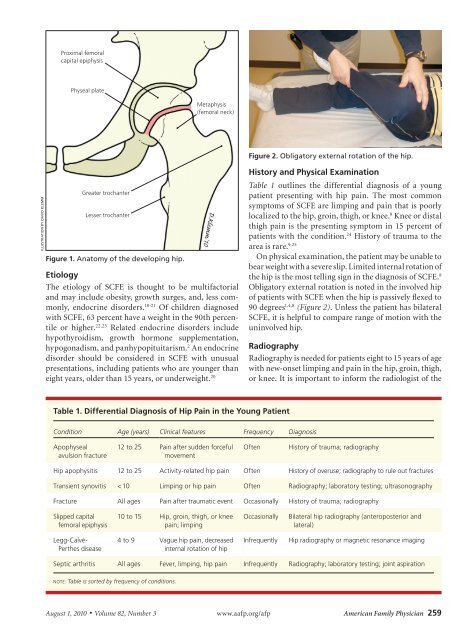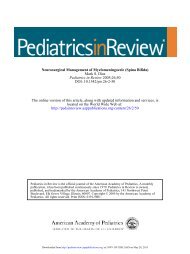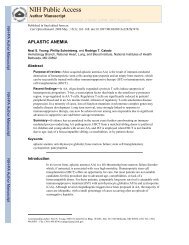Slipped Capital Femoral Epiphysis: Diagnosis and Management
Slipped Capital Femoral Epiphysis: Diagnosis and Management
Slipped Capital Femoral Epiphysis: Diagnosis and Management
You also want an ePaper? Increase the reach of your titles
YUMPU automatically turns print PDFs into web optimized ePapers that Google loves.
ILLUSTRATION BY dAvId kLemm<br />
Proximal femoral<br />
capital epiphysis<br />
Physeal plate<br />
Etiology<br />
The etiology of SCFE is thought to be multifactorial<br />
<strong>and</strong> may include obesity, growth surges, <strong>and</strong>, less commonly,<br />
endocrine disorders. 18-21 Of children diagnosed<br />
with SCFE, 63 percent have a weight in the 90th percentile<br />
or higher. 22,23 Related endocrine disorders include<br />
hypothyroidism, growth hormone supplementation,<br />
hypogonadism, <strong>and</strong> panhypopituitarism. 2 An endocrine<br />
disorder should be considered in SCFE with unusual<br />
presentations, including patients who are younger than<br />
eight years, older than 15 years, or underweight. 20<br />
Table 1. Differential <strong>Diagnosis</strong> of Hip Pain in the Young Patient<br />
<strong>Slipped</strong> <strong>Capital</strong> <strong>Femoral</strong> <strong>Epiphysis</strong><br />
History <strong>and</strong> Physical Examination<br />
Condition Age (years) Clinical features Frequency <strong>Diagnosis</strong><br />
Apophyseal<br />
avulsion fracture<br />
12 to 25 Pain after sudden forceful<br />
movement<br />
Table 1 outlines the differential diagnosis of a young<br />
patient presenting with hip pain. The most common<br />
symptoms of SCFE are limping <strong>and</strong> pain that is poorly<br />
localized to the hip, groin, thigh, or knee. 8 Knee or distal<br />
thigh pain is the presenting symptom in 15 percent of<br />
patients with the condition. 24 History of trauma to the<br />
area is rare. 9,25<br />
On physical examination, the patient may be unable to<br />
bear weight with a severe slip. Limited internal rotation of<br />
the hip is the most telling sign in the diagnosis of SCFE. 8<br />
Obligatory external rotation is noted in the involved hip<br />
of patients with SCFE when the hip is passively flexed to<br />
90 degrees 1,4,8 (Figure 2). Unless the patient has bilateral<br />
SCFE, it is helpful to compare range of motion with the<br />
uninvolved hip.<br />
Radiography<br />
Radiography is needed for patients eight to 15 years of age<br />
with new-onset limping <strong>and</strong> pain in the hip, groin, thigh,<br />
or knee. It is important to inform the radiologist of the<br />
Often History of trauma; radiography<br />
Hip apophysitis 12 to 25 Activity-related hip pain Often History of overuse; radiography to rule out fractures<br />
Transient synovitis < 10 Limping or hip pain Often Radiography; laboratory testing; ultrasonography<br />
Fracture All ages Pain after traumatic event Occasionally History of trauma; radiography<br />
<strong>Slipped</strong> capital<br />
femoral epiphysis<br />
Legg-Calvé-<br />
Perthes disease<br />
Greater trochanter<br />
Lesser trochanter<br />
Figure 1. Anatomy of the developing hip.<br />
10 to 15 Hip, groin, thigh, or knee<br />
pain; limping<br />
4 to 9 Vague hip pain, decreased<br />
internal rotation of hip<br />
Occasionally Bilateral hip radiography (anteroposterior <strong>and</strong><br />
lateral)<br />
Infrequently Hip radiography or magnetic resonance imaging<br />
Septic arthritis All ages Fever, limping, hip pain Infrequently Radiography; laboratory testing; joint aspiration<br />
nOTe: Table is sorted by frequency of conditions.<br />
Metaphysis<br />
(femoral neck)<br />
Figure 2. Obligatory external rotation of the hip.<br />
August 1, 2010 ◆ Volume 82, Number 3 www.aafp.org/afp American Family Physician 259





